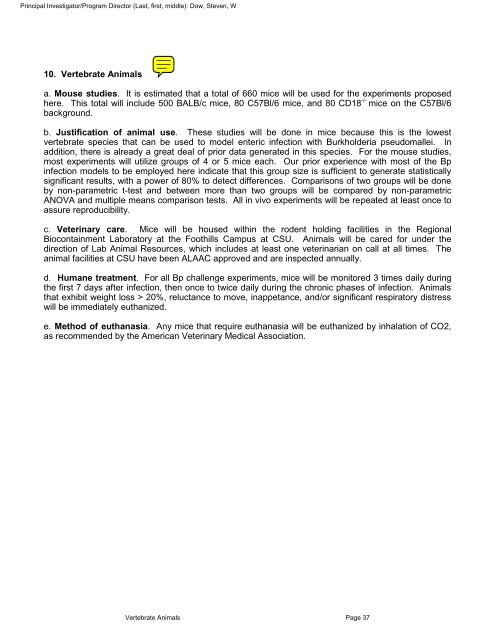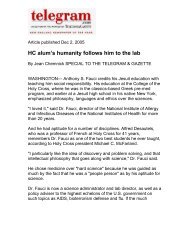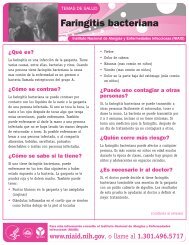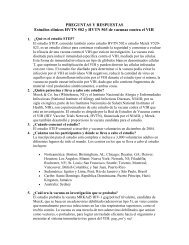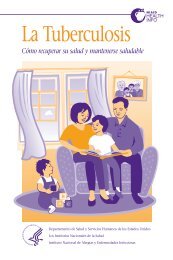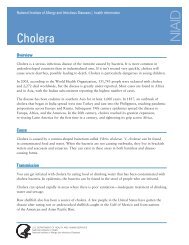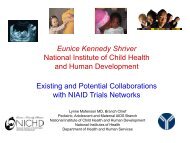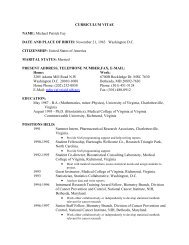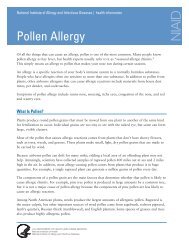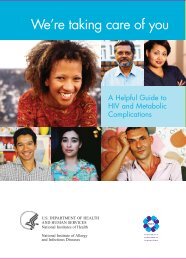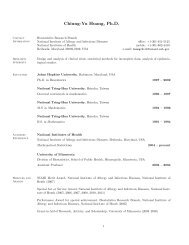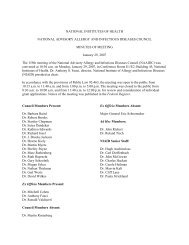Sample Grant Application - NIAID - National Institutes of Health
Sample Grant Application - NIAID - National Institutes of Health
Sample Grant Application - NIAID - National Institutes of Health
Create successful ePaper yourself
Turn your PDF publications into a flip-book with our unique Google optimized e-Paper software.
Principal Investigator/Program Director (Last, first, middle): Dow, Steven, W<br />
10. Vertebrate Animals<br />
a. Mouse studies. It is estimated that a total <strong>of</strong> 660 mice will be used for the experiments proposed<br />
here. This total will include 500 BALB/c mice, 80 C57Bl/6 mice, and 80 CD18 -/- mice on the C57Bl/6<br />
background.<br />
b. Justification <strong>of</strong> animal use. These studies will be done in mice because this is the lowest<br />
vertebrate species that can be used to model enteric infection with Burkholderia pseudomallei. In<br />
addition, there is already a great deal <strong>of</strong> prior data generated in this species. For the mouse studies,<br />
most experiments will utilize groups <strong>of</strong> 4 or 5 mice each. Our prior experience with most <strong>of</strong> the Bp<br />
infection models to be employed here indicate that this group size is sufficient to generate statistically<br />
significant results, with a power <strong>of</strong> 80% to detect differences. Comparisons <strong>of</strong> two groups will be done<br />
by non-parametric t-test and between more than two groups will be compared by non-parametric<br />
ANOVA and multiple means comparison tests. All in vivo experiments will be repeated at least once to<br />
assure reproducibility.<br />
c. Veterinary care. Mice will be housed within the rodent holding facilities in the Regional<br />
Biocontainment Laboratory at the Foothills Campus at CSU. Animals will be cared for under the<br />
direction <strong>of</strong> Lab Animal Resources, which includes at least one veterinarian on call at all times. The<br />
animal facilities at CSU have been ALAAC approved and are inspected annually.<br />
d. Humane treatment. For all Bp challenge experiments, mice will be monitored 3 times daily during<br />
the first 7 days after infection, then once to twice daily during the chronic phases <strong>of</strong> infection. Animals<br />
that exhibit weight loss > 20%, reluctance to move, inappetance, and/or significant respiratory distress<br />
will be immediately euthanized.<br />
e. Method <strong>of</strong> euthanasia. Any mice that require euthanasia will be euthanized by inhalation <strong>of</strong> CO2,<br />
as recommended by the American Veterinary Medical Association.<br />
Vertebrate Animals Page 37


